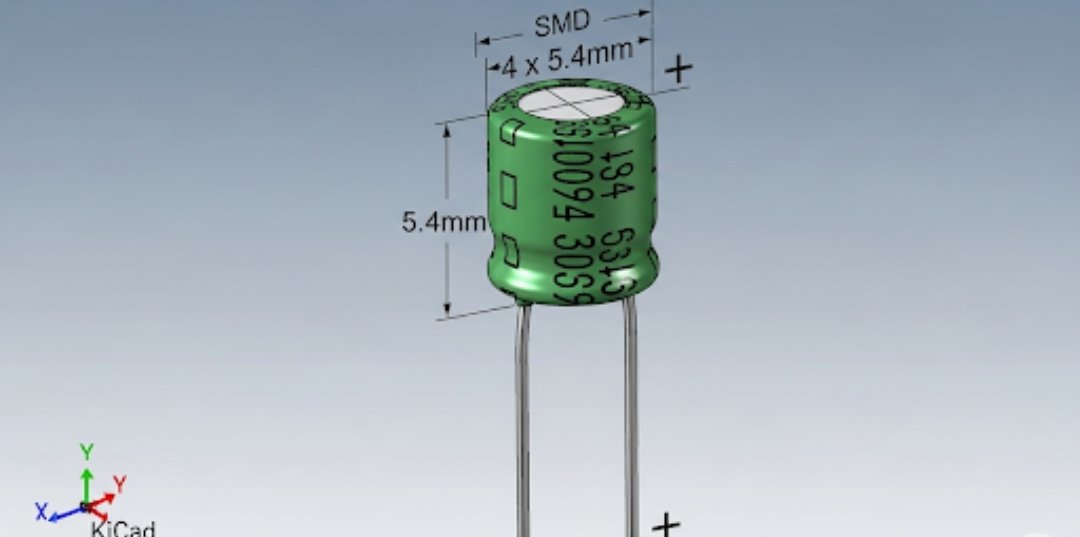Creating Accurate PCB Designs with the SMD 4 x 5.4mm Electrolytic Capacitor KiCad Model
In the world of electronics design, precision and accuracy are everything—especially when working with small, surface-mounted components. As any PCB designer knows, having the right component models in your EDA (Electronic Design Automation) software can make or break a project. That’s why the smd 4 x 5.4mm electrolytic capacitor KiCad model is gaining popularity among designers and engineers who rely on KiCad for high-quality, reliable circuit board designs.
Whether you’re a professional electronics engineer or a hobbyist building your latest prototype, getting the dimensions, footprints, and 3D views correct from the start is crucial. In this article, we’ll explore what makes this particular capacitor model special, how to use it effectively in KiCad, and why integrating accurate models into your workflow can save you time, money, and headaches.
Understanding the SMD 4 x 5.4mm Electrolytic Capacitor
Before diving into the software side, let’s break down what this component actually is. The smd 4 x 5.4mm electrolytic capacitor is a surface-mount device with a cylindrical shape, measuring 4mm in diameter and 5.4mm in height. These compact capacitors are commonly used in applications where space is limited but relatively high capacitance values are needed, such as in power supply filtering, decoupling, and energy storage.
Their small size makes them ideal for densely packed PCBs in consumer electronics, IoT devices, and compact embedded systems. However, this same small form factor makes it even more critical that the model you use in your design software matches the physical component precisely.
Why the KiCad Model Matters
KiCad, as a powerful and free open-source EDA suite, has grown significantly in popularity in recent years. However, its vast library of components is not always complete when it comes to specific, non-standard sizes like the smd 4 x 5.4mm electrolytic capacitor KiCad model. Having the correct model available means:
- Accurate PCB footprint: Ensuring correct solder pad size and spacing prevents costly rework.
- 3D visualization: Allows you to view how the component fits with others in your final assembly.
- Automated checks: Enables successful design rule checks (DRC) and electrical rule checks (ERC) without errors.
- Manufacturing readiness: Minimizes delays in production due to component mismatches.
If your capacitor doesn’t physically fit on the board you designed in KiCad, that’s not just a design flaw—it could be a production disaster.
Finding or Creating the SMD 4 x 5.4mm Electrolytic Capacitor KiCad Model
So how do you get the smd 4 x 5.4mm electrolytic capacitor KiCad model into your project? Here are your best options:
1. Search KiCad’s Community Libraries
KiCad has an active community, and there’s a good chance someone has already created the footprint or 3D model you need. Start by searching the KiCad GitHub libraries or popular community forums like the KiCad.info forum.
2. Use Third-Party Model Libraries
Websites like SnapEDA, UltraLibrarian, or SamacSys offer downloadable models specifically for KiCad. You can often find the exact dimensions, pad layouts, and even branded models from capacitor manufacturers.
3. Build It Yourself
If you’re comfortable with KiCad’s footprint editor and 3D modeling tools, creating your own smd 4 x 5.4mm electrolytic capacitor KiCad model is entirely feasible. You’ll just need the component’s datasheet, a basic understanding of KiCad’s model-making tools, and a bit of patience.
Pro tip: Always double-check your footprint against the mechanical drawing in the datasheet, and if possible, test your model in a dummy layout before using it in production.
Tips for Using the Model Effectively
Once you’ve added the smd 4 x 5.4mm electrolytic capacitor KiCad model to your project, keep these best practices in mind:
- Label correctly: Use descriptive designators to ensure you can quickly identify the capacitor’s purpose (e.g., C1, C2).
- Layer organization: Make sure the pads, silkscreen, and courtyard are correctly assigned to their respective layers.
- Orientation matters: Most electrolytic capacitors are polarized. Always check the pin 1 marking and match it with the polarity indicator on your schematic and PCB layout.
- Use 3D viewer: Always open the 3D viewer in KiCad to confirm placement and spacing before sending files to a manufacturer.
Real-World Applications
Designers working on compact consumer electronics, battery-powered devices, and power-efficient microcontroller systems are frequently using the smd 4 x 5.4mm electrolytic capacitor KiCad model to improve their designs. One engineer noted that switching to precise models reduced his prototype rework time by over 30%.
Another hobbyist shared on Reddit: “Using an exact capacitor model in KiCad for the first time felt like I leveled up. The 3D fit check alone saved me from a layout mistake I didn’t catch in 2D.”
These real experiences reinforce the importance of component accuracy in modern PCB design workflows.
Conclusion
As electronics continue to shrink and complexity increases, the tools we use must evolve to keep pace. The smd 4 x 5.4mm electrolytic capacitor KiCad model is a small but crucial part of this process. Whether you’re designing your next IoT gadget or refining a product for mass production, using accurate, reliable models in KiCad is key to success.
So next time you reach for that 4mm x 5.4mm capacitor, make sure you have the right KiCad model to match. It’s a small step that can make a big difference in the quality, reliability, and manufacturability of your final product.







